Maytag HAV2460AWW User Manual [en, fr, es]
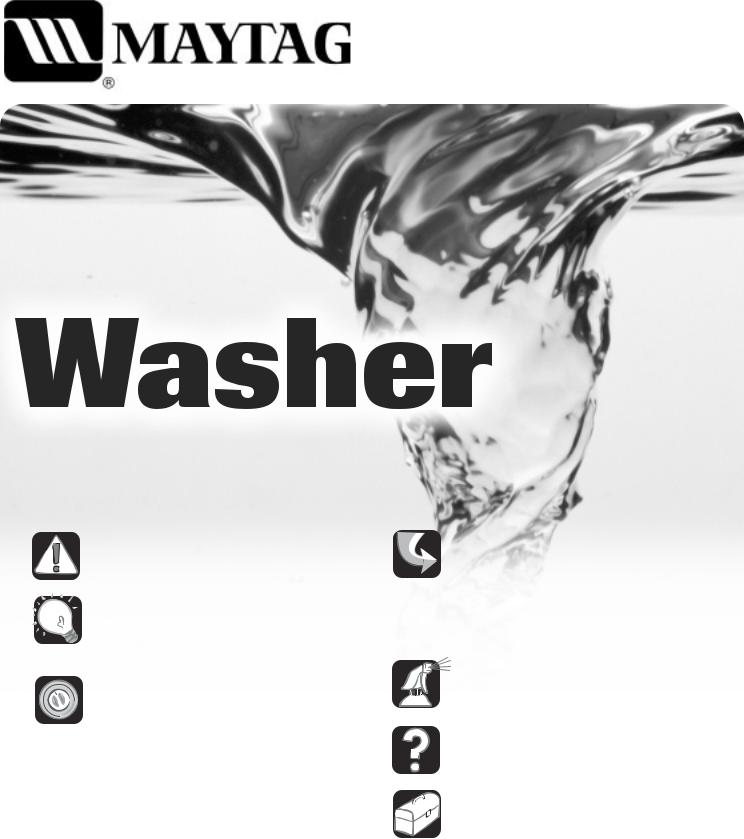
HAVBB-1
Use & Care Guide
Table of Contents
Important Safety Instructions 1-2
Operating Tips . . . . . . . . . . 3-4
Detergent
Loading
Additional Tips
Using the Controls
(Two-Speed Models) . . . . . . . . 5-6
Select Water Level
Select Wash/Rinse Temperature Select Cycle
Pull Control Dial Out to Start
(Three-Speed Models) . . . . . . . 7-8
Select Water Level
Select Extra Rinse
Select Wash/Rinse Temperature Select Cycle
Pull Control Dial Out to Start
(Four-Speed Models) . . . . . . . 9-10
Select Water Level
Select Wash/Rinse Temperature Select Wash/Spin Speed
Select Cycle Select Options
Pull Control Dial Out to Start
Special Features . . . . . . . 11-12
Liquid Bleach Dispenser
Fabric Softener Dispenser
Automatic Lint Filtering System
Safety Spin
Unbalanced Spin Load Compensator
Overload Protector
Care & Cleaning . . . . . . . . . . 12
Troubleshooting . . . . . . . . 13-14
Service & Warranty . . . . . . . . 15
Guide d’utilisation
et d’entretien . . . . . . . . . . . 16
Guía de uso y cuidado . . . . . 32
Form No. A/07/03 |
Part No. 35-6811 |
www.maytag.com |
Litho U.S.A. |
©2003 Maytag Appliances Sales Co. |



 Important Safety Instructions
Important Safety Instructions
Installer: Please leave this manual with this appliance.
Consumer: Please read and keep this manual for future reference. Keep sales receipt and/or canceled check as proof of purchase.
Model Number _______________________________
Serial Number ________________________________
Date of Purchase ______________________________
If you have questions, call:
Maytag Customer Assistance 1-800-688-9900 U.S.A. 1-800-688-2002 Canada (Mon.-Fri., 8am-8pm Eastern Time) Internet: http://www.maytag.com
U.S. Customers using TTY for deaf, hearing impaired or speech impaired, call 1-800-688-2080.
In our continuing effort to improve the quality and performance of our appliances, it may be necessary to make changes to the appliance without revising this guide.
For service information, see page 13.
What You Need to Know About Safety Instructions
Warning and Important Safety Instructions appearing in this manual are not meant to cover all possible conditions and situations that may occur. Common sense, caution and care must be exercised when installing, maintaining or operating appliance.
Always contact your dealer, distributor, service agent or manufacturer about problems or conditions you do not understand.
Recognize Safety Symbols, Words,
Labels
 WARNING
WARNING
WARNING – Hazards or unsafe practices which COULD result in severe personal injury or death.
 CAUTION
CAUTION
 WARNING! FIRE HAZARD
WARNING! FIRE HAZARD
Do not add gasoline, dry-cleaning solvents, or other flammable or explosive substances to the wash water. These substances give off vapors that could ignite or explode.
Do not wash articles which have been previously cleaned, washed, soaked, or spotted with gasoline, dry-cleaning solvents, oil, waxes, chemical solvents, alcohol, turpentine, or other flammable or explosive materials. These substances will be retained in articles, and articles which still contain these flammable or explosive substances give off vapors that could ignite or explode.
Observe these precautions when using cleaning fluids, spot or stain removers, etc. These products should be labeled “nonflammable.” Use according to manufacturers directions in a well ventilated area or outdoors. Thoroughly rinse articles by hand before placing them in the washer. Some of these products
– rust removers for example – will damage components and the finish of the washer.
Keep area around and underneath washer free from the accumulation of combustible materials, such as lint, paper, rags, gasoline, and all other flammable vapors and liquids.
HYDROGEN GAS IS EXPLOSIVE! Under certain conditions, hydrogen gas may be produced in a hot water system that has not been used for two weeks or more. If the hot water system has not been used for such a period, before using the washer, turn on all the hot water faucets and let the water flow from each faucet for several minutes. This will release any accumulated hydrogen gas. As this gas is flammable, do not smoke or use an open flame during this time.
Recent studies have shown that if vegetable oil contaminated materials are incompletely washed, a carry-over and buildup of the oil may contribute to a chemical reaction (spontaneous combustion) that could cause a load to catch fire by itself. This would be more likely to happen if the load were left in the dryer after tumbling stopped or if items were folded and stacked while warm.
CAUTION – Hazards or unsafe practices which COULD result in minor personal injury.
1



 Important Safety Instructions
Important Safety Instructions
 WARNING
WARNING
To reduce the risk of fire, explosion, electric shock, or personal injury when using your washer, follow basic safety precautions, including the following:
1.Read all instructions before using the appliance.
2.As with any equipment using electricity and having moving parts, there are potential hazards. To use this appliance safely, the operator should become familiar with the instructions for operation of the appliance and always exercise care when using it.
3.Do not install or store this appliance where it will be exposed to the weather.
4.Install and level washer on a floor that can support the weight.
5.This appliance must be properly grounded. Never plug the appliance cord into a receptacle which is not grounded adequately and in accordance with local and national codes. See installation instructions for grounding this appliance.
6.To avoid the possibility of fire or explosion:
a.Do not wash items that have been previously cleaned in, washed in, soaked in, or spotted with gasoline, dry-cleaning solvents, other flammable or explosive substances as they give off vapors that could ignite or explode. Hand wash and line dry any items containing these substances.
Any material on which you have used a cleaning solvent, or which is saturated with flammable liquids or solids, should not be placed in the washer until all traces of these liquids or solids and their fumes have been removed.
These items include acetone, denatured alcohol, gasoline, kerosene, some liquid household cleaners, some spot removers, turpentine, waxes and wax removers.
b.Do not add gasoline, dry-cleaning solvents, or other flammable or explosive substances to the wash water. These substances give off vapors that could ignite or explode.
c.Under certain conditions, hydrogen gas may be produced in a hot water system that has not been used for two weeks or more. HYDROGEN GAS IS EXPLOSIVE. If the hot water system has not been used for such a period, before using a washing machine or combination washer-dryer, turn on all hot water faucets and let the water flow from each for several minutes. This will release any
accumulated hydrogen gas. As the gas is flammable, do not smoke or use an open flame during this time.
D.Do not wash or dry items that are soiled with vegetable or cooking oil. These items may contain some oil after laundering. Due to the remaining oil, the fabric may smoke or catch fire by itself.
7.Do not reach into the appliance if the tub or agitator is moving.
8.Do not allow children or pets to play on, in, or in front of the appliance. Close supervision is necessary when the appliance is used near children and pets.
9.Do not tamper with controls.
10.Do not repair or replace any part of the appliance or attempt any servicing unless specifically recommended in published user-repair instructions that you understand and have the skills to carry out.
11.Unplug power supply cord before attempting to service your washer. Service is to be done only by qualified service personnel.
12.The agitator should not be removed. If the agitator is removed, it must be replaced by pushing down completely and the locking screw tightened before the washer is operated.
13.Keep all laundry aids such as detergents, bleach, etc., out of the reach of children, preferably in a locked cabinet. Use laundry aids only as directed by the manufacturer. Observe all warnings on container labels.
14.Keep the area around and underneath washer free from the accumulation of combustible materials, such as lint, paper, rags, gasoline, and all other flammable vapors and liquids.
15.Do not use chlorine bleach and ammonia or acids (such as vinegar or rust remover) in the same wash. Hazardous fumes can form.
16.Do not machine wash fiberglass materials. Small particles can stick to fabrics washed in following loads and cause skin irritation.
17.For flame resistant finishes - follow garment manufacturer's instructions carefully. Improper laundering could remove the finish.
18.Before the appliance is removed from service or discarded, remove the door to the washing compartment.
19.Inlet hoses are subject to damage and deterioration over time. Check the hoses periodically for bulges, kinks, cuts, wear or leaks and replace them every five years.
SAVE THESE INSTRUCTIONS
2
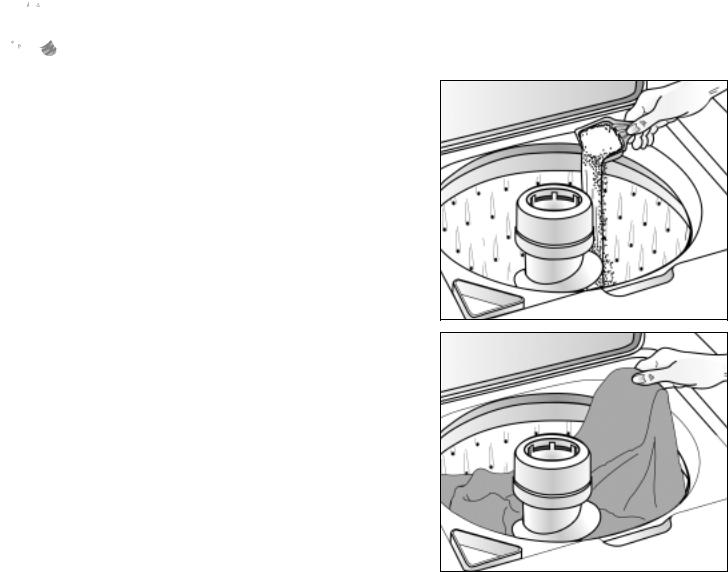





 Operating Tips
Operating Tips
Detergent
•Use either liquid or granular laundry detergent. For best results, be sure detergent is added to the washer BEFORE the load and be sure the wash water is above 65° F.
•Use the correct amount of detergent for the load size, soil level and water conditions. Use more detergent if you have hard water and very soiled loads.
If you have soft water or a lightly soiled load, use less detergent. (See manufacturer’s instructions.)
•Wipe up any detergent spills on the washer.
Loading
•Put dry, unfolded clothes loosely in the tub, up to the top row of holes for a maximum load.
•Do not wrap large items like sheets around the agitator.
•Mix large and small items for best circulation. Wash bulky items like blankets separately.
•When laundering wrinkle free items or items of delicate construction, washable woolens or loosely knit items, never use less than the MEDIUM water level setting. This will minimize shrinkage, wrinkling and pulling of seams.
•For best results add the detergent to the washtub before adding the load.
•Close lid carefully to avoid slamming.
3






 Operating Tips
Operating Tips
Additional tips
•During the spin, it is possible for the load to become unevenly distributed in the tub. If this happens, push in the control knob, open the lid, redistribute the load, close the lid and pull out the control knob. The spin will resume at the point it was interrupted.
•The washer will pause briefly throughout each cycle. These pauses are normal.
•This washer is designed so that it will not spin when the lid is open. It will, however, fill and agitate with the lid open so water is available for pretreating stains or diluting fabric softener.
•If you open the lid during a spin cycle, the washer will stop. When the lid is closed and the control dial pulled out, the washer will continue the cycle at the point it was interrupted.
For detailed information on sorting, pretreating stains, etc., see the enclosed Laundering Tips brochure.
4
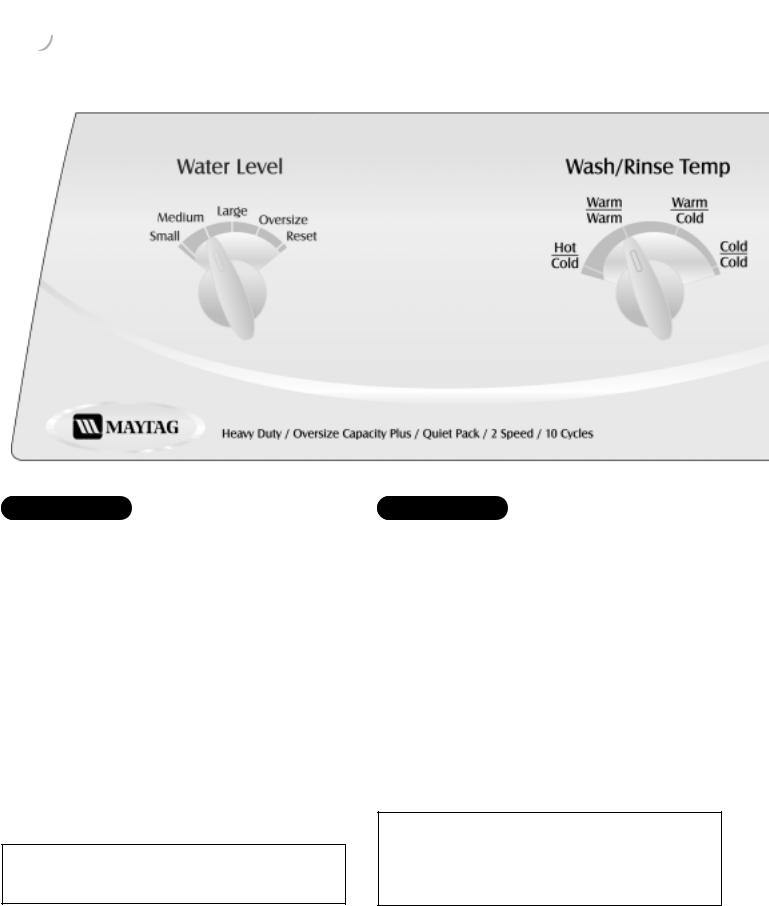


 Using the Controls – Two-Speed Models
Using the Controls – Two-Speed Models
STEP 1
Level
selected setting based on clothes load should provide sufficient water to permit
freely during agitation.
It may become necessary, due to bulky fabrics, to adjust the water level after agitation begins. To adjust the water level, turn the control to reset and then back to the desired setting.
WATER LEVEL SETTING |
LOAD SIZE |
|
|
Small |
1/4 Full |
|
|
Medium |
1/4 – 1/2 Full |
|
|
Large |
1/2 – 3/4 Full |
|
|
Oversize |
3/4 – Full |
|
|
Note
• Items must circulate freely for best results.
STEP 2
Select Wash/Rinse Temperature
Your washer gives you a choice of hot, warm or cold water for washing and cold or warm water for rinsing. Use the chart below as a guide.
WASH/RINSE |
LOAD TYPE |
|
TEMPS |
|
|
Hot/Cold |
White and heavily soiled, color-fast |
|
items |
||
|
||
|
|
|
Warm/Warm |
Delicate items |
|
|
|
|
Warm/Cold |
Moderately soiled, colored items; |
|
most permanent press items |
||
|
||
|
|
|
Cold/Cold |
Brightly colored, lightly soiled |
|
items; washable woolens |
||
|
||
|
|
Note
• In wash water temperatures below 65° F, detergents do not dissolve well or clean well. Care labels define cold water as up to 85° F.
5
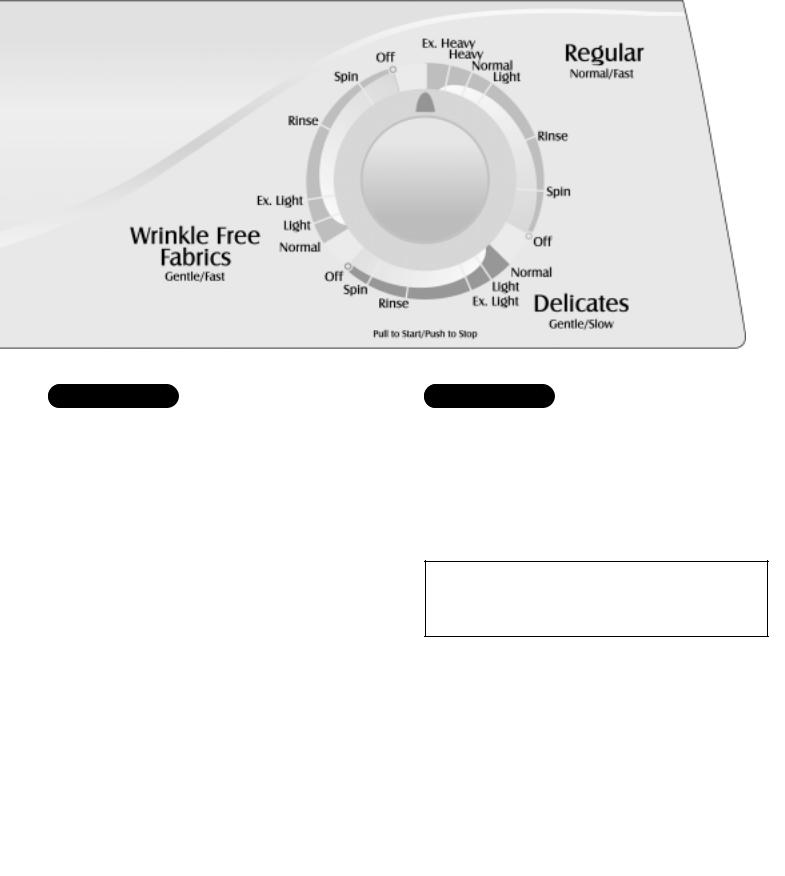
Control features vary by model.
STEP 3
push the control dial IN (off position) right (clockwise) until the pointer is
needed for the wash load in the Free Fabrics or Delicates cycles.
Cycle
agitation and normal spin speeds to heavily soiled items. For maximum
dial at Extra Heavy.
Fabrics Cycle
agitation and fast spin speed to protect
.
STEP 4
Pull Control Dial Out to Start
You may stop the washer at any time by simply pushing the control dial IN. Therefore it is possible to obtain a non-agitated soak or to shorten, skip or repeat any part of a cycle. The control dial must be pushed IN (off position) when you change the setting.
Note
•Do not attempt to turn the control dial counterclockwise. Damage to the timer will result.
agitation speed and slow spin speed for |
See Laundering Tips for proper washing procedures, |
. |
stain removal, and special laundering situations. |
6
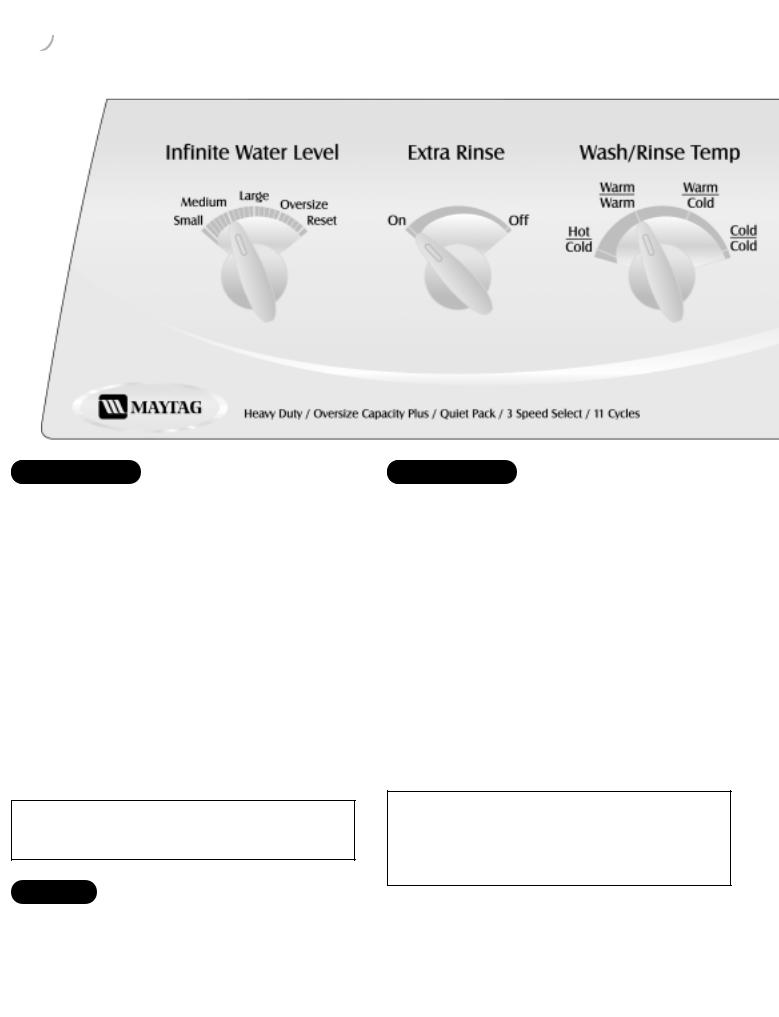


 Using the Controls – Three-Speed Models
Using the Controls – Three-Speed Models
STEP 1
Level
selected setting based on clothes load should provide sufficient water to permit
freely during agitation.
necessary, due to bulky fabrics, to level after agitation begins. To adjust
turn the control to reset and then back setting.
WATER LEVEL SETTING |
LOAD SIZE |
|
|
Small |
1/4 Full |
|
|
Medium |
1/4 – 1/2 Full |
|
|
Large |
1/2 – 3/4 Full |
|
|
Oversize |
3/4 – Full |
|
|
Note
• Items must circulate freely for best results.
|
STEP |
2 |
|
|
|
Rinse (if desired) |
|
|
|
is in the “On” position, an additional |
|
|
|
of the Regular, Wrinkle Free Fabrics |
|
|
|
cycles is provided to more completely |
|
7 |
|
additives, suds, perfumes, etc. |
|
STEP 3
Wash/Rinse Temperature
gives you a choice of hot, warm or cold and cold or warm water for rinsing.
below as a guide.
WASH/RINSE |
LOAD TYPE |
|
TEMPS |
|
|
Hot/Cold |
White and heavily soiled, color-fast |
|
items |
||
|
||
|
|
|
Warm/Warm |
Delicate items |
|
|
|
|
Warm/Cold |
Moderately soiled, colored items; |
|
most wrinkle-free items |
||
|
||
|
|
|
Cold/Cold |
Brightly colored, lightly soiled |
|
items; washable woolens |
||
|
||
|
|
Note
•In wash water temperatures below 65° F, detergents do not dissolve well or clean well. Care labels define cold water as up to 85° F.
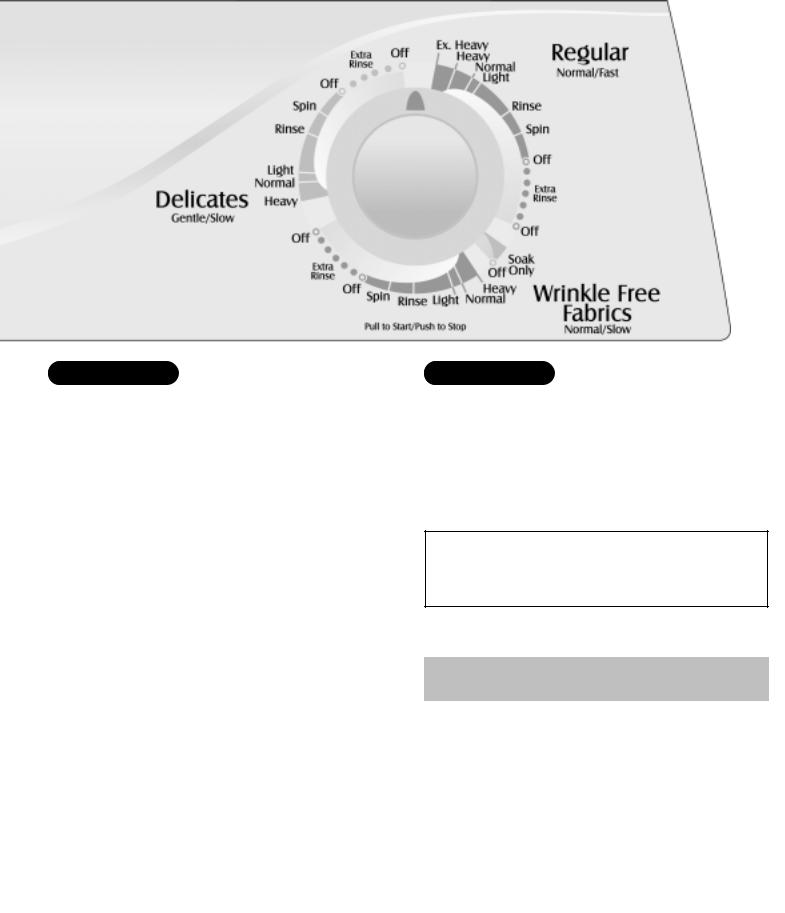
Control features vary by model.
STEP 4
push the control dial IN (off position) right (clockwise) until the pointer is
needed for the wash load in the Free Fabrics or Delicates cycles.
Cycle
agitation and normal spin speeds to heavily soiled items. For maximum
dial at Extra Heavy.
Fabrics Cycle
agitation and slow spin speed to free fabrics.
agitation speed and slow spin speed for
.
of agitation and then soak. Avoid
– soak for 30 minutes or less. must be manually advanced to a spin
and drain the water.
STEP 5
Pull Control Dial Out to Start
You may stop the washer at any time by simply pushing the control dial IN. Therefore it is possible to obtain a non-agitated soak or to shorten, skip or repeat any part of a cycle. The control dial must be pushed IN (off position) when you change the setting.
Note
•Do not attempt to turn the control dial counterclockwise. Damage to the timer will result.
See Laundering Tips for proper washing procedures, stain removal, and special laundering situations.
8
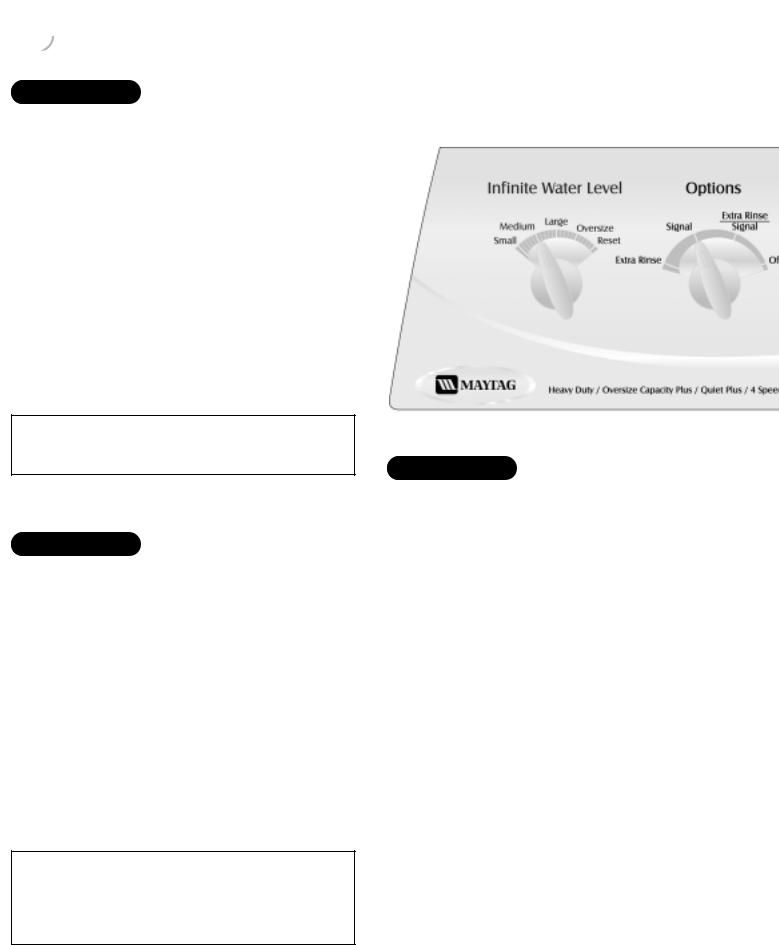


 Using the Controls – Four-Speed Models
Using the Controls – Four-Speed Models
STEP 1
Level
selected setting based on clothes load models, the infinite control allows you to
setting or anywhere in between.
necessary, due to bulky fabrics, to level after agitation begins. To adjust
turn the control to reset and then back setting.
WATER LEVEL SETTING |
LOAD SIZE |
|
|
Small |
1/4 Full |
|
|
Medium |
1/4 – 1/2 Full |
|
|
Large |
1/2 – 3/4 Full |
|
|
Oversize |
3/4 – Full |
|
|
Note |
|
• Items must circulate freely for best results. |
STEP 3 |
|
STEP 2
|
Temperature |
|
|
you a choice of hot, warm or cold |
|
|
and cold or warm water for rinsing. |
|
|
as a guide. |
|
|
|
|
WASH/RINSE |
LOAD TYPE |
|
TEMPS |
|
|
Hot/Cold |
White and heavily soiled, color-fast |
|
items |
||
|
||
|
|
|
Warm/Warm |
Delicate items |
|
Warm/Cold |
Moderately soiled, colored items; |
|
most permanent press items |
||
|
||
|
|
|
Cold/Cold |
Brightly colored, lightly soiled |
|
items; washable woolens |
||
|
||
|
|
Note
• In wash water temperatures below 65° F, detergents do not dissolve well or clean well. Care labels define cold water as up to 85° F.
Wash/Spin Speed
has selectable wash and spin speed
|
FABRIC |
LOAD TYPE |
||
SELECTION |
|
|||
|
Regular |
|
Sturdy fabrics needing maximum |
|
|
water extraction like jeans, towels |
|||
|
Normal/Fast |
|||
|
and bedding |
|||
|
|
|
||
|
|
|
|
|
|
Wrinkle Free |
Sturdy fabrics needing a slower spin |
||
|
speed to reduce wrinkling, such as |
|||
|
Normal/Slow |
|||
|
dress shirts and dress pants |
|||
|
|
|
||
|
|
|
|
|
|
Delicate |
|
Delicate fabrics needing slower spin |
|
|
speed because of clothing |
|||
|
Gentle/Slow |
|||
|
construction |
|||
|
|
|
||
|
|
|
|
|
|
Handwash |
|
Intermittent slow agitation and soak |
|
|
to gently wash the most delicate |
|||
Ex. Gentle/Slow |
||||
items |
||||
|
|
|
|
|
9
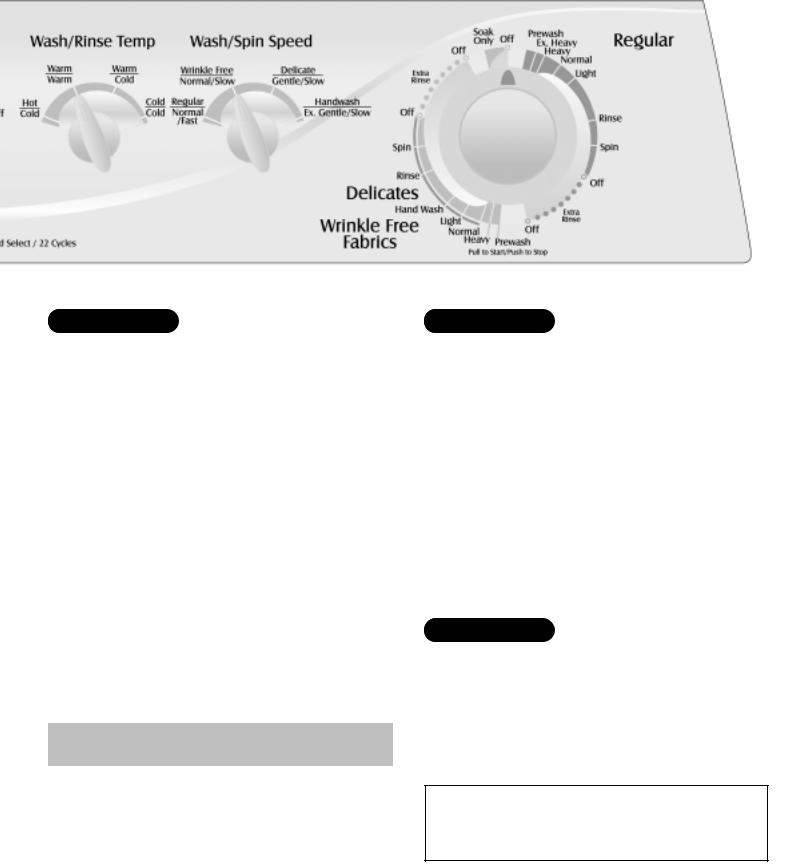
STEP 4
push the control dial IN and turn it to until the pointer is at the soil level
wash load.
Fabrics/Delicates Cycle
cycles share the same control dial. For wrinkle free fabrics,
and turn the Wash/Spin Speed dial to
. For delicate loads select Delicates.
up to 16 minutes of agitation. Wash/Spin Speed.
(select models)
of agitation, then soak. Avoid
– soak for 30 minutes or less. must be manually advanced to a spin
and drain the water.
See Laundering Tips for proper washing procedures, stain removal, and special laundering situations.
STEP 5
is in the “Extra Rinse” position, an
at the end of the Regular and Wrinkle cycles is provided to more
laundry additives, suds, perfumes, etc.
signal will sound once the cycle is end of cycle signal can be canceled by to off.
and an end of cycle signal are Options knob to Extra Rinse/Signal.
STEP 6
Pull Control Dial Out to Start
You may stop the washer at any time by simply pushing the control dial IN. Therefore it is possible to obtain a non-agitated soak or to shorten, skip or repeat any part of a cycle. The control dial must be pushed IN (off position) when you change the setting.
Note
•Do not attempt to turn the control dial counterclockwise. Damage to the timer will result.
10
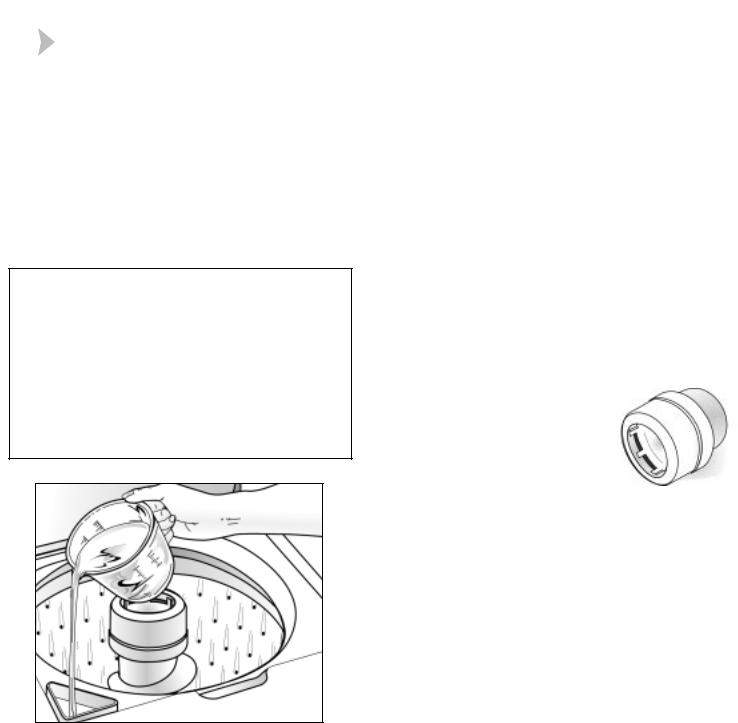


 Special Features
Special Features
Liquid Bleach Dispenser
The dispenser automatically dilutes liquid chlorine bleach before it reaches your wash load. To use, follow these steps:
1.Measure liquid chlorine bleach carefully, following the instructions on the bottle.
2.Add the bleach to the dispenser before adding the load. Avoid splashing or over-filling the dispenser.
Note
•Never pour undiluted liquid chlorine bleach directly onto the load or into the wash tub. It is a powerful chemical and can cause fabric damage, such as tearing or color loss, if not used properly.
•If you prefer to use color-safe, non-chlorine bleach, pour it into the wash tub with your detergent. Do not pour non-chlorine bleaches into the bleach dispenser.
Pour liquid chlorine bleach into bleach dispenser.
Fabric Softener Dispenser
The dispenser automatically releases liquid fabric softener at the proper time during the cycle. To use, follow these steps:
1.Pour a measured amount of fabric softener into the dispenser to fill line only.
2.If fabric softener comes below line, add warm water.
If it is necessary to clean the dispenser:
1.Pull the dispenser off of the top of the agitator.
2.Soak for one hour in sink or container in hot water and dishwashing liquid.
3.Hold hands over top and bottom of dispenser and shake to loosen buildup.
4.Rinse with clean, hot water.
5.Repeat process if necessary.
6.Replace dispenser on agitator.
Do not use dishwashing liquid inside the washer. Oversudsing can occur.
Automatic Lint Filtering System
The Lint Filtering System does not require cleaning.
Wash and rinse water is filtered and re-filtered continuously to trap lint shed by most fabrics during the agitation cycle before it can be redeposited on the wash load. The engineered hole design on the wash basket in conjunction with water flow produced by the agitator, traps lint away from the clothes between the inner wash basket and the outer tub. Lint is automatically flushed from the washer during the spin cycle.
Safety Spin
If for any reason you open the washer lid when the washer is in a spin or extract period, the operation will immediately stop. This is for your personal safety. If your washer does not stop, call your service technician immediately. When the lid is closed, the operation will automatically resume.
11



 Special Features
Special Features
Unbalanced Spin
Load Compensator
Your new washer is designed to handle out-of-balance loads without shutting down or interrupting the washing cycle.
For this reason, the cycle will always be completed. If heavier fabrics in such out-of-balance loads should ever contain excessive moisture at the completion of the cycle, redistribute the clothes in the washer and reset the control dial for the final spin period.
Overload Protector
A built-in protector automatically shuts off the washer motor in case of an overload. This can occur if:
•The load being washed is too heavy.
•Too many appliances are plugged into the line operating your washer.
•A low voltage condition exists on the line.
•Lid is opened and closed repeatedly.
The overload protector permits the washer to start again when the motor has cooled to a safe operating temperature.
If the motor stops repeatedly, call your service technician.


 Care & Cleaning
Care & Cleaning
1.After washing, leave the lid open until the interior is dry.
2.Check hoses to be sure there are no kinks or knots.
3.Your washer should not be installed where temperatures will go below freezing, as damage to the washer could result.
4.To clean, occasionally wipe exterior with a clean damp sponge or cloth. Do not use polish on plastic parts.
5.Lifetime lubrication is done at the factory, so your washer never needs to be oiled or greased.
6.Do not lay heavy or sharp objects on top of your washer.
7.The top of the washer should not be used for removing stains from garments. Some stain removers, such as rust remover, will mar the finish.
8.Remove pins, buckles or other sharp objects from clothes to prevent scratching interior parts.
9.Clothes should not be stored in washer.
10.Bleach, detergent, solvents, etc. spilled on the top of your washer that are allowed to remain will remove the glossy finish. Remove all spills with a damp, soft cloth.
11.If you close your home for the winter, have a service technician drain the washer. Unplug cord from electrical outlet and disconnect hoses from faucets.
Cleaning the Interior
The interior of the washer should be cleaned periodically to remove dirt, soil, odor or bacteria residue that may remain in the washer as a result of washing clothes. We recommend taking the following steps every 60 to 120 days to clean and freshen your washer interior. The frequency with which the washer should be cleaned and freshened depends on factors such as usage, the amount of dirt, soil or bacteria being run through your washer, or the use of cold water.
To clean and freshen the washer interior:
1.Add a measured amount of chlorine bleach to the bleach dispenser, following package directions.
2.Add 1/4 cup of detergent to the tub.
3.Run the washer through a complete cycle using hot water.
4.Repeat the process if necessary.
12



 Troubleshooting
Troubleshooting
For problem laundry |
solutions (i.e. fabric damage, residue, tangling) and special laundry care procedures, |
||
see the enclosed Laundering Tips brochure. |
|||
|
|
|
|
Won’t Fill |
|
• |
Plug cord into live electrical outlet. |
|
|
• |
Check fuse or reset circuit breaker. |
|
|
• |
Turn the control knob to proper cycle and pull knob out to start the washer. |
|
|
• |
Turn both faucets on fully. |
|
|
• |
Straighten inlet hoses. |
|
|
• |
Disconnect hoses and clean screens. Hose filter screens may be plugged. |
|
|
|
|
Won’t Agitate |
|
• |
Check fuse or reset circuit breaker. |
|
|
• |
Make sure the lid is completely closed. |
|
|
• |
Turn the control knob to proper cycle and pull knob out to start the washer. |
|
|
• |
Pauses are normal. Wait and see if the washer will start again. |
|
|
|
|
Won’t Spin or Drain |
|
• |
Check fuse or reset circuit breaker. |
|
|
• |
Straighten drain hoses. Eliminate kinked hoses. If there is a home drain restriction, |
|
|
|
call for drain service. |
|
|
• |
Close lid and pull knob out to start the washer. For your safety, washer will not spin |
|
|
|
unless the lid is closed. |
|
|
• |
Suds lock – caused by too much suds. Rewash without detergent. Use correct |
|
|
|
amount of a low-sudsing detergent. |
|
|
|
|
Load is Wet |
|
• |
Unevenly distributed load. Redistribute the load, close the lid and pull knob out. |
|
|
|
Check for leveling. Be sure water level is acceptable for load size. |
|
|
• |
A normal spin speed is recommended for heavy loads like jeans or towels. |
|
|
|
|
Stops |
|
• |
Plug cord into live electrical outlet. |
|
|
• |
Check fuse or reset circuit breaker. |
|
|
• |
Close lid and pull knob out to start the washer. For your safety, washer will not spin |
|
|
|
unless lid is closed. |
|
|
• |
This may be a pause in the cycle. Wait briefly and it may start. |
|
|
|
|
Leaks Water |
|
• |
Make sure hose connections are tight. |
|
|
• |
Make sure end of drain hose is correctly inserted and secured to drain facility. |
|
|
• |
Avoid extended soaking – soak for 30 minutes or less. |
|
|
• |
Avoid overloading. |
|
|
|
|
Is Noisy |
|
• |
Be sure washer is leveled properly as outlined in installation manual. |
|
|
• |
Weak floors can cause vibration and walking. |
|
|
• |
Operating sounds will vary depending on agitation speed. |
|
|
|
|
13



 Troubleshooting
Troubleshooting
Fills with the Wrong |
• |
Turn both faucets on fully. |
Temperature Water |
• |
If equipped with a temperature selector knob, be sure it is set directly on a |
|
||
|
|
temperature setting and not between settings. |
|
• |
Make sure temperature selection is correct. |
|
• |
Make sure hoses are connected to correct faucets and inlet connections. Be sure |
|
|
water supply is regulated correctly. Flush water line before filling washer. |
|
• |
Check the water heater. It should be set to deliver a minimum 120° F (49° C) hot |
|
|
water at the tap. Also check water heater capacity and recovery rate. |
|
• |
Disconnect hoses and clean screens. Hose filter screens may be plugged. |
|
|
|
Cycle Selector |
• |
Extra Rinse (select models) is selected. |
Advances Through Off |
|
|
|
|
|
For further assistance contact Maytag ServicesSM, Maytag Customer Assistance: U.S. 1-800-688-9900 or Canada 1-800-688-2002.
U.S. Customers using TTY for deaf, hearing impaired or speech impaired, call 1-800-688-2080.
14
